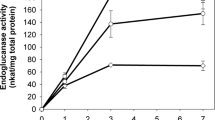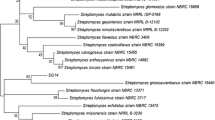Abstract
The wild type filamentous fungus, Melanocarpus albomyces, produces many commercially valuable enzymes, including Xylanases and Xylan-debranching enzymes with low activity. In this paper, we report for the first time the development of M. albomyces mutants from vegetative spores. Profuse sporulation of M. albomyces was induced on Potato Carrot Agar medium. These spores, when subjected to chemical mutation, led to the isolation of the hyper-xylanase producing mutant, viz, M. albomyces IITD3A. Various parameters including number of spores, nitrogen source and C/N ratio of the medium were optimized for production of xylanase by the mutant in a shake flask culture. Under controlled pH at 7.8, the mutant produced highly active xylanase with 415 IU/mL after 36 h of growth on soluble alkaline lignocellulosic extract in a 14-L fermentor. The overall productivity of xylanase was 8-fold higher than the wild type culture with11, 530 IU/L/h. The enzyme can be easily stored at 37°C for 50 days by addition of a small amount of the preservative — thiomersal. Also, for long term storage, a lyophilized powder form of the enzyme can be used which retained 100% of its activity for > 50 days. When assayed at pH 7.5 and temperature 55°C, the xylanase retained 100% of its original activity, and also at pH 9.0, it retained > 50% of its activity for 2 h, which is promising for its application in the pulp and paper industry.
Similar content being viewed by others
References
Polizeli, M. L. T. M., A. C. S. Rizzatti, R. Monti, H. F. Terenzi, J. A. Jorge, and D. S. Amorim (2005) Xylanases from fungi: Properties and industrial applications. Appl. Microbiol. Biotechnol. 67: 577–591.
Kang, M. K., P. J. Maeng, and Y. H. Rhee (1996) Purification and characterization of two xylanases from alkalophilic Cephalosporium sp. strain RYM-202. Appl. Environ. Microbiol. 62: 3480–3482.
Panagiotou, G., D. Kekos, B. J. Macris, and P. Christakopoulos (2003) Production of cellulolytic and xylanolytic enzymes by Fusarium oxysporum grown on corn stover in solid state fermentation. Ind. Crops Produc. 18: 37–45.
Saraswat, V. and V. S. Bisaria (1997) Biosynthesis of xylanolytic and xylan debranching enzymes in Melanocarpus albomyces IIS 68. J. Ferment. Bioeng. 83: 352–357.
Chandra, R. K. and T. S. Chandra (1995) A cellulase-free xylanase from alkali-tolerant Aspergillus fischeri Fxn1. Biotechnol. Lett. 17: 309–314.
Maheshwari, R. and P. T. Kamalam (1985) Isolation and culture of a thermophilic fungus, Melanocarpus albomyces and factors influencing the production and activity of xylanase. J. Gen. Microbiol. 131: 3017–3027.
Saraswat, V. and V. S. Bisaria (2000) Purification, characterization and substrate specificities of xylanase isoenzymes from Melanocarpus albomyces IIS 68. Biosci. Biotechnol. Biochem. 64: 1173–1180.
Bisaria, V. S., S. Mishra, and V. Sahai (2002) Enzymatic prebleaching of Kraft pulps for paper manufacture. Proceedings of International Conference on Tropical Bioresources and Green Chemistry Strategy. October 27–31. Osaka, Japan.
Kiiskinen, L. L., L. Viikari, and K. Kruus (2002) Purification and characterization of a novel laccase from the ascomycete Melanocarpus albomyces. Appl. Microbiol. Biotechnol. 59: 198–204.
Kiiskinen, L. L., H. Palonen, M. Linder, L. Viikari, and K. Kruus (2004) Laccase from Melanocarpus albomyces binds effectively to cellulose. FEBS Lett. 576: 251–255.
Hirvonen, M. and A. C. Papageorgiou (2003) Crystal structure of a family 45 endoglucanase from Melanocarpus albomyces: Mechanistic implications based on the free and cellobiose-bound forms. J. Mol. Biol. 329: 403–410.
Kontkanen, H., M. Tenkanen, and T. Reinikainen (2006) Purification and characterization of a novel steryl esterase from Melanocarpus albomyces. Enz. Microb. Technol. 39: 265–273.
Tatum, E. L., R. W. Barratt, and V. M. Cutter (1949) Chemical induction of colonial paramorphs in Neurospora and Syncephalastrum. Science 109: 509–511.
Biely, P., D. Mislovicova, and T. Rudolf (1988) Remazol brilliant Blue-xylan: A soluble Chromogenic substrate for xylanases. Methods Enzymol. 160: 536–541.
Sahai, V., S. Mishra, and V. S. Bisaria (2005) Cellulose-free nutrient medium for enhanced productivity and activity of cellulase-free enzymes. Indian Patent 1246/DEL/2005.
Bailey, M. J., P. Biely, and K. Poutenan (1992) Laboratory testing of methods for assay of xylanase activity. J. Biotechnol. 23: 257–270.
Miller, G. L. (1959) Use of dinitrosalicylic acid regent for determination of reducing sugar. Anal. Chem. 31: 426–428.
Skromne, I., O. Sanchez, and J. Aguirre (1995) Starvation stress modulates the expression of the Aspergillus nidulans brlA regulatory gene. Microbiol. 141: 21–28.
Morton, A. G. (1961) The induction of sporulation in mould fungi. Proc. Roy. Microscop. Soc. B 153: 548–569.
Righelato, R. C., A. P. J. Trinci, S. J. Pirt, and A. Peat (1968) The influence of maintenance energy and growth rate on the metabolic activity, morphology and conidiation of Penicillium chrysogenum. J. Gen. Microbiol. 50: 399–412.
Wulf, P. D., W. Soetaert, D. Schwengers, and E. J. Vandamme (1996) Screening and mutational improvement of a D-ribose secreting Candida pelliculosa strain. J. Ferment. Bioeng. 82: 1–7.
Smith, G. and C. Calam (1980) Variations in inocula and their influence on the productivity of antibiotic fermentations. Biotechnol. Lett. 2: 261–266.
Papagianni, M. and M. Mattey (2006) Morphological development of Aspergillus niger in submerged citric acid fermentation as a function of the spore inoculum level. Application of neural network and cluster analysis for characterization of mycelia morphology. Microb. Cell Fact. 5: 3.
Haltrich, D., M. Preiss, and W. Steiner (1993) Optimization of a culture medium for increased xylanase production by a wild strain of Schizophyllum commune. Enz. Microb. Technol. 15: 854–860.
Smith, D. C. and T. M. Wood (1991) Xylanase production by Aspergillus awamori: Development of a medium and optimization of the fermentation parameters for the production of extracellular xylanase and β-xylosidase while maintaining low protease production. Biotechnol. Bioeng. 38: 883–890.
Song, A. R., X. M. Tian, G. F. Feng, and Y. Q. Zhang (2001) A study of the utilization of Pleurotus eryngii with different carbon and nitrogen sources. Acta Edulis Fungi 8: 10–14.
Qinnghe, C., Y. Xiaoyu, N. Tiangui, J. Cheng, and M. Qiugang (2004) The screening of culture conditions and properties of xylanase by white-rot fungus Pleurotus ostreatus. Proc. Biochem. 39: 1561–1566.
Haltrich, D., B. Nidetzky, K. D. Kulbe, W. Steiner, and S. Zupancic (1996) Production of fungal xylanases. Bioresour. Technol. 58: 137–161.
Dobrev, G. T., I. G. Pishtiyski, V. S. Stanchev, and R. Mircheva (2007) Optimization of nutrient medium containing agricultural wastes for xylanase production by Aspergillus niger B03 using optimal composite experimental design. Bioresour. Technol. 98: 2671–2678.
Oliveira, L. A., A. L. F. Porto, and E. B. Tambourgi (2006) Production of xylanase and protease by Penicillium janthinellum CRC 87M-115 from different agricultural wastes. Bioresour. Technol. 97: 862–867.
Dwivedi, P., V. Vivekanand, R. Ganguly, and R. P. Singh (2009) Parthenium sp. as a plant biomass for the production of alkalitolerant xylanase from mutant Penicillium oxalicum SAUE-3.510 in submerged fermentation. Biomass Bioener. 33: 581–588.
Li, Y., F. Cui, Z. Liu, Y. Xu, and H. Zhao (2007) Improvement of xylanase production by Penicillium oxalicum ZH-30 using response surface methodology. Enz. Microb. Technol. 40: 1381–1388.
Lichstein, H. C. and M. H. Soule (1944) Studies of the effect of sodium azide on microbic growth and respiration I. The action of sodium azide on microbic growth. J. Bact. 47: 221–230.
Magos, L. (2001) Review on the toxicity of ethylmercury, including its presence as a preservative in biological and pharmaceutical products. J. Appl. Toxicol. 21: 1–5.
Shatalov, A. A. and H. Pereira (2007) Xylanase pre-treatment of giant reed organosolv pulps: Direct bleaching effect and bleach boosting. Indus.Crops Products 25: 248–256.
Techapun, C., T. Charoenrat, N. Poosaran, M. Watanabe, and K. Sasak (2002) Thermostable and alkaline-tolerant cellulase-free xylanase produced by thermotolerant Streptomyces sp. Ab106. J. Biosci. Bioeng. 93: 431–433.
Khandeparkar, R. and N. B. Bhosle (2007) Purification and characterization of thermoalkalophilic xylanase isolated from the Enterobacter sp. MTCC 5112. Res. Microbiol. 157: 315–325.
Author information
Authors and Affiliations
Corresponding author
Rights and permissions
About this article
Cite this article
Biswas, R., Sahai, V., Mishra, S. et al. Development of mutants of Melanocarpus albomyces for hyperproduction of xylanase. Biotechnol Bioproc E 15, 800–809 (2010). https://doi.org/10.1007/s12257-010-0015-1
Received:
Revised:
Accepted:
Published:
Issue Date:
DOI: https://doi.org/10.1007/s12257-010-0015-1




